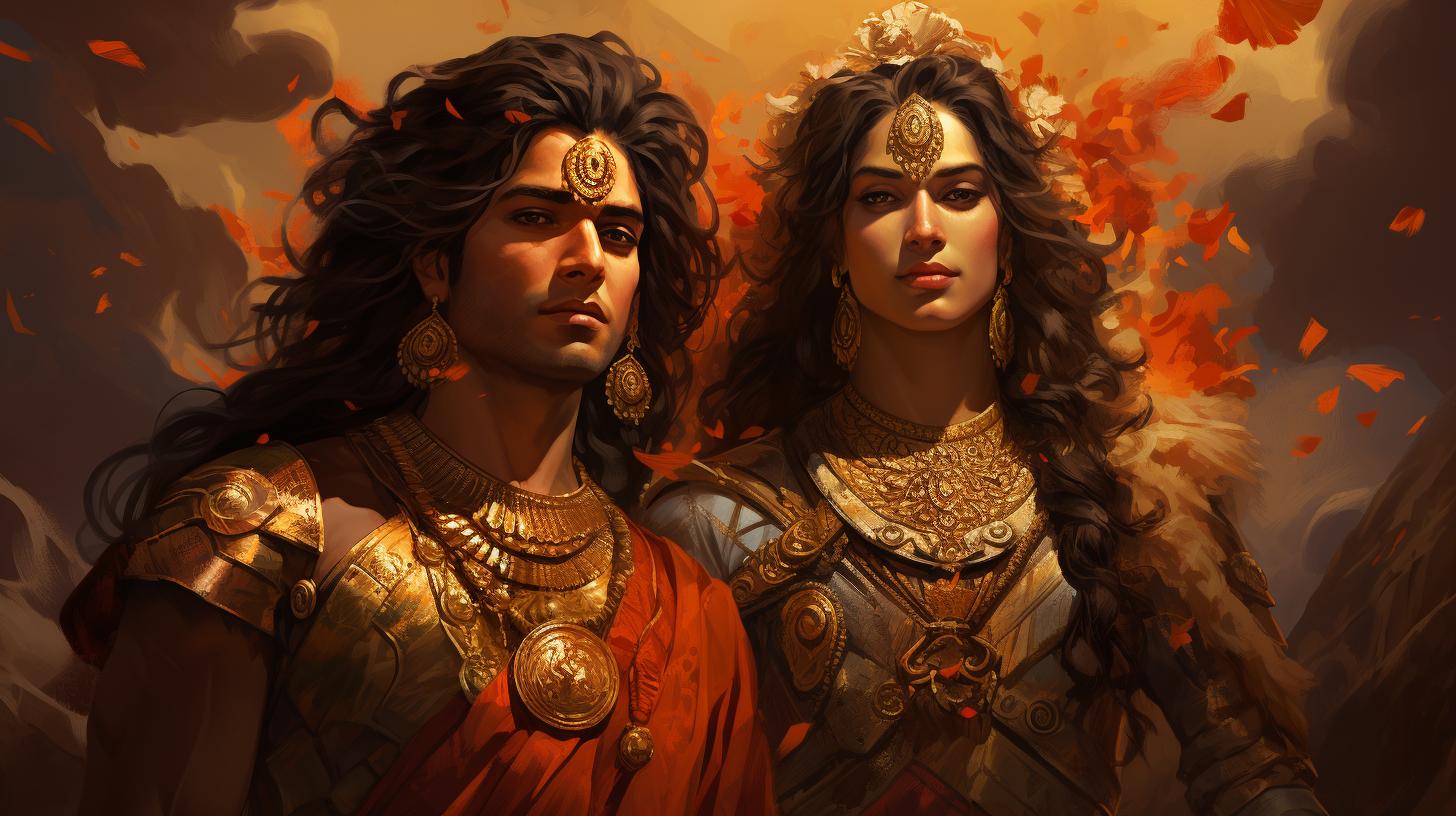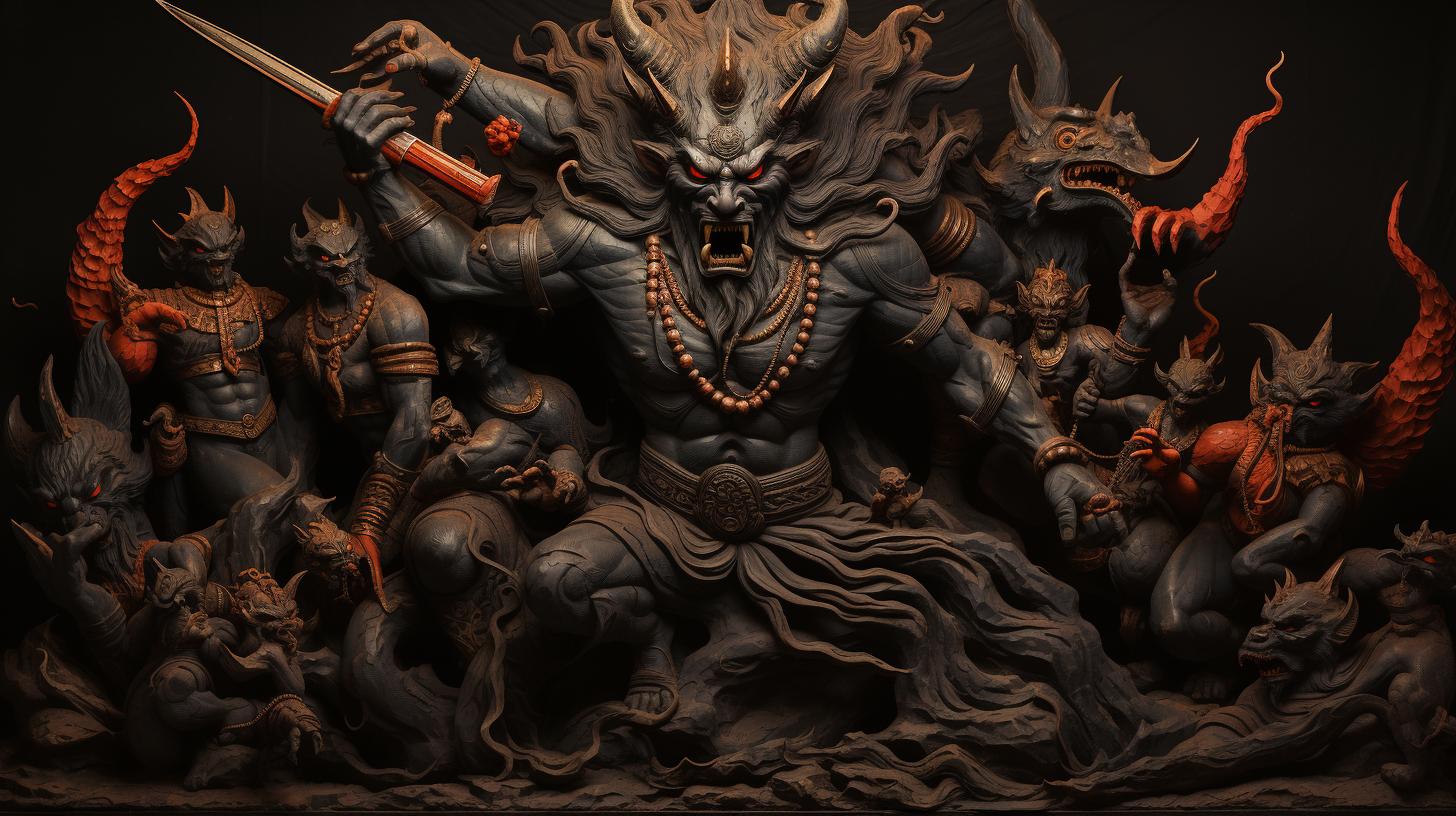Annapurna: Goddess of Food on the Hindu Mythology

Annapurna, the goddess of food in Hindu mythology, holds a prominent place in Indian culture and religion. Known as the divine mother, she is revered for her role in nourishing and providing sustenance.
Temples dedicated to Annapurna can be found in various parts of India, such as the Annapoorna Temple in Horanadu and the Annapurna Devi Mandir in Varanasi. Through ancient hymns and prayers, like the Annapurna Sahasranam Stotram, devotees express their devotion to this goddess.
Food has sacred significance in Hinduism, and Annapurna symbolizes its importance in both physical and spiritual nourishment.
The Legend of Annapurna: Origins and Mythology
Annapurna, the goddess of food in Hindu mythology, is surrounded by fascinating origins and rich mythology. According to ancient texts and scriptures, Annapurna is considered a manifestation of the divine mother, Parvati. She is revered for her abundance and nourishing nature, symbolizing the importance of food and sustenance in life.
The legend of Annapurna traces back to the time of the gods and demons, known as devas and asuras, respectively. It is said that during a great cosmic turmoil, the devas were deprived of their strength and vitality.
Seeking a solution, they sought Lord Shiva’s guidance, who advised them to worship Parvati as Annapurna, the provider of food and nourishment. Pleased with their devotion, Annapurna blessed them with an unending supply of food, revitalizing the devas and restoring balance to the universe.
The mythology surrounding Annapurna further emphasizes her role as the goddess of food and sustenance. Her name, Annapurna, derives from Sanskrit, with “anna” meaning food and “purna” meaning full or complete.
She is depicted as a compassionate and gentle mother figure, ensuring that no one goes hungry and everyone is nourished. Her acts of grace and abundance have solidified her position as a revered deity in Hindu traditions.
Annapurna’s portrayal in ancient texts and scriptures reflects the profound significance of food and nutrition in Hinduism. It highlights the belief that sustenance is not merely a physical requirement but also a spiritual one.
Through the worship of Annapurna, devotees seek blessings for good health, prosperity, and blessed sustenance. The stories and legends associated with Annapurna reverberate with the core values of compassion, gratitude, and the interconnectedness of all beings.
Annapurna’s Manifestation as the Divine Mother
In Hindu mythology, Annapurna is revered as the divine mother, representing nurturing, care, and abundance. She embodies the essence of maternal love and is seen as the ultimate provider of sustenance and nourishment.
Devotees worship Annapurna as the ultimate source of sustenance, seeking her blessings for abundance and prosperity in all aspects of life.
Her maternal nature provides a sense of assurance and comfort to those who turn to her in times of need.
Annapurna’s manifestation as the divine mother also represents the cyclic nature of creation and destruction.
Just as a mother nourishes her child, she also has the power to destroy and transform. This duality exemplifies the awe-inspiring and multifaceted nature of the goddess.
Her presence as the divine mother extends beyond physical nourishment, emphasizing the significance of spiritual growth and enlightenment.
Annapurna’s devotees believe that through her guidance and blessings, they can attain spiritual fulfillment and inner nourishment, ultimately leading to a sense of wholeness.
By recognizing Annapurna as the divine mother, Hindus acknowledge the vital role of nurturing and nourishment in the cycle of life.
They express their devotion through prayers, offerings, and rituals centered around her, seeking her blessings for abundance and well-being.
The manifestation of Annapurna as the divine mother holds great significance in Hindu culture, emphasizing the importance of nurturing, care, and sustenance that extends beyond the realm of physical food.
Her presence as the divine mother provides solace and guidance, exemplifying the compassionate and all-encompassing nature of the goddess.
Annapurna Temples: Places of Worship and Devotion
The reverence for Annapurna, the goddess of food, is palpable in the numerous temples dedicated to her across India. These sacred places of worship serve as gathering grounds for devotees seeking to express their devotion and seek blessings from the divine mother.
The most renowned temple dedicated to Annapurna is the Annapoorna Temple in Horanadu, where thousands of devotees visit each year. This temple, situated amidst the picturesque Western Ghats, is believed to have been constructed around the 13th century by the renowned sage Agastya.
It stands as a testament to the deep-rooted faith and belief in Annapurna’s benevolence and ability to provide sustenance to her devotees.
Another significant place of devotion is the Annapurna Devi Mandir in Varanasi, also known as the City of Light.
Located on the banks of the holy river Ganges, this temple offers a serene atmosphere for devotees to offer prayers and pay homage to the goddess. The temple showcases the divine presence of Annapurna, embodying abundance and nourishment for all.
These temples are not just religious sites; they are cultural and spiritual centers that hold deep significance for devotees. The vibrant ambiance, adorned with intricate carvings and sculptures, creates an aura of devotion and reverence.
It is believed that by visiting these temples and partaking in the religious ceremonies, one can attain spiritual growth and be blessed with prosperity and well-being.
Throughout the year, various festivals and celebrations dedicated to Annapurna are held in these temples.
The Annapurna temples serve as reminders of the divine presence in our lives, emphasizing the importance of gratitude, nourishment, and the interconnectedness of spirituality and physical sustenance.
Annapurna Sahasranam Stotram: A Thousand Names of the Goddess
The Annapurna Sahasranam Stotram is a sacred hymn dedicated to Annapurna, the goddess of food and nourishment.
This hymn comprises a thousand names that are chanted in devotion and reverence to the goddess.
Each name carries profound symbolism, reflecting the divine qualities and aspects of Annapurna.
The recitation of the Annapurna Sahasranam Stotram is considered a significant spiritual practice in Hinduism. It is believed that by chanting these thousand names, devotees invoke the blessings and grace of the goddess.
This sacred hymn serves as a powerful tool for seeking prosperity, abundance, and sustenance in all aspects of life.
Symbolism and Meaning
Every name in the Annapurna Sahasranam Stotram carries deep symbolism, illuminating different facets of the goddess. Some of these names highlight Annapurna’s role as the provider of food, emphasizing her abundance, nourishment, and ability to satiate hunger.
Other names depict her as the embodiment of motherly love, compassion, and generosity. Through these names, devotees gain insight into the divine nature of Annapurna and seek her blessings for both physical and spiritual nourishment.
Devotional Practice
Devotees recite the Annapurna Sahasranam Stotram with utmost devotion and reverence. The chanting can be performed individually or in congregations, accompanied by traditional musical instruments and rhythmic melodies. Many devotees undertake dedicated rituals and fasting as a form of penance while engaging in the recitation.
During special festivals and auspicious occasions dedicated to Annapurna, such as Annapurna Jayanti, devotees gather in temples or their homes to chant the thousand names, expressing their gratitude and seeking the goddess’s blessings.
The soothing and melodic recitation of the hymn creates an atmosphere of serenity and devotion, deepening the connection between the devotee and the goddess.
Significance
The Annapurna Sahasranam Stotram holds immense significance in the lives of those who worship Annapurna. It is believed that through the recitation of these sacred names, devotees receive blessings for nourishment, fulfillment of desires, and spiritual growth.
The hymn establishes a profound connection with Annapurna, reminding devotees of her omnipresence and the vital role she plays in their lives.
By immersing oneself in the recitation of the Annapurna Sahasranam Stotram, devotees seek the goddess’s grace, aspiring to attain abundance and sustenance in all aspects of life, both material and spiritual.
The Sacred Significance of Food in Hinduism
Food holds a profound spiritual significance in Hinduism, and this belief is exemplified through the worship of the goddess Annapurna. In Hindu culture, food is seen as a divine offering, a source of vital energy, and a means of connecting with the spiritual realm.
According to Hindu scriptures, Annapurna governs the nourishment of all living beings and is responsible for providing sustenance and abundance. She is revered as the giver of food, symbolizing the importance of gratitude, sustenance, and the cyclical nature of life.
Hindus recognize the act of eating as a sacred ritual and consider it a means to honor and show appreciation for Annapurna’s divine blessings. Before consuming a meal, it is customary to offer prayers, dedicating the food to God and seeking blessings for health and well-being.
The concept of ‘Prasadam’ in Hinduism further emphasizes the sacredness of food. Prasadam refers to food that has been offered to deities during religious ceremonies and then distributed among devotees. It is believed that consuming Prasadam brings spiritual purification and bestows the blessings of the gods.
Moreover, Hindu scriptures emphasize the idea of practicing moderation and gratitude when it comes to food. It encourages individuals to approach meals with mindfulness, recognizing the interconnectedness of all living beings and the privilege of being nourished.
The rituals and beliefs surrounding food in Hinduism reflect the cultural values of reverence, gratitude, and appreciation for the blessings of sustenance. The worship of Annapurna not only emphasizes the importance of physical nourishment but also encourages individuals to cultivate a deeper awareness and connection with the divine through the act of eating.
Annapurna’s Role in Providing Nourishment and Spiritual Growth
Annapurna, the goddess of food, plays a vital role in providing nourishment, not only in a physical sense but also in a spiritual context. She is revered as the divine source of sustenance, ensuring that her devotees are blessed with abundant food and nourishment.
According to Hindu mythology, Annapurna’s benevolence extends beyond mere provision of sustenance. She is believed to nourish the soul and aid in spiritual growth. Her devotees understand the significance of the food they consume as a means to purify the body and elevate their spiritual well-being.
Annapurna’s association with food goes beyond its material aspect. She represents the concept of anna, which encompasses not just physical food but also the essence of cosmic energy that sustains all life forms.
Through her divine presence, Annapurna guides individuals on their spiritual journey, transcending the realm of worldly desires and nurturing the soul.
The worship of Annapurna is often accompanied by prayers and rituals centered around offering food to the deity.
Devotees acknowledge the divine grace of Annapurna as they partake in the sanctified meal, recognizing that food is a sacred gift and a means to attain spiritual enlightenment.
Furthermore, Annapurna’s role in spiritual growth is reflected in the belief that true nourishment extends beyond the physical body.
As individuals practice mindfulness while consuming food, they cultivate a deeper connection with the divine energy present in every morsel. This practice instills gratitude and fosters a sense of unity with the divine, leading to spiritual growth and enlightenment.
Annapurna’s presence in the lives of her devotees serves as a constant reminder of the sacredness of nourishment and the potential for spiritual transformation. Through her blessings, individuals not only satisfy their physical hunger but also embark on a journey of self-discovery and spiritual awakening.
Annapurna Celebrations and Festivals
The celebration of Annapurna is an integral part of Hindu traditions and is marked with various festivals and rituals dedicated to the goddess of food. These celebrations are often vibrant and joyous, bringing communities together to pay homage to Annapurna.
One of the prominent festivals celebrated in honor of Annapurna is Annapurna Jayanti, which commemorates the birthday or manifestation day of the goddess. Devotees engage in special prayers, fasting, and offering of food to seek blessings for prosperity and abundance.
During the festival of Navratri, which spans over nine nights, Annapurna is worshiped as one of the manifestations of Goddess Durga. The festival culminates with Kanya Pujan, where young girls are revered as the embodiment of Annapurna and are offered food and blessings.
- Other significant festivals dedicated to Annapurna include Diwali, the festival of lights, where the goddess is invoked for blessings of wealth and abundance.
- Makar Sankranti, the harvest festival, is also a time when Annapurna’s blessings are sought for agricultural prosperity.
- Pongal, celebrated in South India, is another harvest festival where gratitude is expressed towards Annapurna for a bountiful harvest.
These festivals showcase the deep-rooted connection between Annapurna and the importance of food in people’s lives.
They serve as a reminder to be grateful for the sustenance provided by the goddess and to share it with others.
Annapurna’s Influence on Cuisine and Food Practices in India
One cannot underestimate the profound influence of Annapurna, the goddess of food, on cuisine and food practices in India. Her divine presence has shaped not only the way food is prepared and consumed but also the rituals and customs associated with it.
1. Rituals and Offerings: Annapurna’s worship has given rise to various rituals and offerings centered around food. Devotees offer prasadam, a sacred food offering, to seek her blessings. This practice emphasizes the importance of gratitude and sharing in the Hindu culture.
- Prasadam: The offering of prasadam is considered sanctified and is believed to carry the blessings of the goddess.
- Bhojanam: The act of sharing meals as a form of offering, often done in temples or during religious ceremonies.
Vegetarianism: Annapurna’s veneration has played a significant role in the prominence of vegetarianism in Indian cuisine.
Hindus, in reverence to the goddess, often adopt a vegetarian lifestyle, considering it pure and aligned with spiritual values.
- Sattvic Diet: Many traditional Indian recipes follow the principles of a sattvic diet, which promotes purity, balance, and spiritual upliftment.
- Awareness of Ahimsa: Annapurna’s influence has heightened the awareness of ahimsa (non-violence), leading to the avoidance of meat and emphasizing the use of plant-based ingredients.
Temples and Community Kitchens: The worship of Annapurna extends beyond individual households and has given rise to a network of community kitchens and food distribution centers.
- Annapurna Mandirs: Temples dedicated to Annapurna often have community kitchens, where free meals are served to devotees and the underprivileged.
- Annadanam: The act of providing free food as a form of selfless service, inspired by Annapurna’s compassion for nourishing all beings.
Culinary Traditions: Annapurna’s influence can be seen in the diverse culinary traditions across different regions of India.
- Regional Specialties: Each region has its own unique dishes and cooking techniques, influenced by local ingredients and cultural practices.
- Spices and Flavors: The use of various spices and flavors in Indian cuisine adds depth and aroma, creating a vibrant culinary experience.
5.
Festivals and Celebrations: Several festivals and celebrations in India are centered around food, highlighting Annapurna’s significance in culinary traditions.
- Navratri: This nine-night festival involves fasting and feasting, with special dishes prepared for each day.
- Pongal: A harvest festival celebrated in South India, where a traditional dish made with freshly harvested rice is offered to Annapurna.
In conclusion, the influence of Annapurna, the goddess of food, on cuisine and food practices in India is profound and far-reaching.
From rituals and offerings to vegetarianism, community kitchens, culinary traditions, and festive celebrations, her divine presence continues to shape the way food is revered, prepared, and shared in Indian culture.
Other Deities Associated with Annapurna
While Annapurna is revered as the primary goddess of food and nutrition, she is also closely associated with other deities in Hindu mythology.
These deities play significant roles alongside Annapurna and collectively contribute to the understanding of food’s spiritual and symbolic importance.
- Ganesha: The son of Parvati and Lord Shiva, Lord Ganesha is often depicted as the remover of obstacles and the god of intellect and wisdom.
He is believed to have a deep connection with food and is associated with the concept of good fortune and prosperity.
- Lakshmi: As the goddess of wealth and prosperity, Lakshmi is often worshipped alongside Annapurna.
Both deities share a common theme of abundance and nourishment, with Lakshmi symbolizing material wealth and Annapurna representing spiritual nourishment.
- Kubera: Known as the treasurer of the gods, Kubera is associated with wealth and riches.
In some traditions, Kubera is considered a guardian of agricultural resources and the provider of abundance, making him an important deity connected to the sustenance of food.
- Kamadhenu: Kamadhenu, also known as the divine cow, is a symbol of fertility and abundance.
She is said to be capable of fulfilling the wishes of those who seek her blessings, including the provision of ample food and sustenance.
- Saraswati: Devi Saraswati, the goddess of knowledge, music, and arts, holds a significant place in Hindu mythology.
She is sometimes associated with Annapurna due to her role in enhancing understanding and creativity, which ultimately contributes to the growth and development of food-related practices.
These deities, alongside Annapurna, form a divine network within Hindu mythology, representing different aspects of nourishment, wealth, wisdom, and creativity.
Together, they reinforce the holistic significance of food and its role in supporting various facets of life.
Annapurna’s Representation in Art and Sculpture
Annapurna, the goddess of food and nutrition, has been depicted in various forms of art and sculpture throughout history. Artists have sought to capture her essence and convey her significance in Hindu mythology and culture.
These artistic representations often showcase Annapurna in her divine form, highlighting her nurturing and nourishing nature.
In sculptures, Annapurna is commonly portrayed sitting on a lotus throne, holding a golden ladle and a bowl filled with food.
This iconic image symbolizes her role as the provider of sustenance and blessings. The lotus flower represents purity and enlightenment, further emphasizing her divine nature.
Artists also depict Annapurna with multiple arms, symbolizing her ability to provide abundance and nourishment to all beings.
In some representations, she is shown with four or eight arms, each holding different objects associated with fertility, agriculture, and the distribution of food.
Another common artistic portrayal of Annapurna is as a motherly figure, radiating warmth and compassion.
This depiction emphasizes her role as a caregiver and protector. She is often depicted with a gentle smile, symbolizing her benevolence and love for her devotees.
Artworks featuring Annapurna can be found in temples, shrines, and art galleries throughout India and Southeast Asia.
These artistic representations not only showcase the talent and creativity of the artists but also serve as a visual reminder of the importance of food and nourishment in Hinduism.
Throughout history, artists have continuously explored different mediums and styles to portray Annapurna’s essence.
From intricate temple carvings to vibrant paintings, these representations capture the essence of the goddess and inspire devotion and reverence among her followers.
In conclusion, Annapurna’s representation in art and sculpture showcases the significance of her role as the goddess of food and nutrition.
These artistic depictions serve as a visual reminder of the importance of nourishment, abundance, and the divine blessings associated with Annapurna’s presence in Hindu culture and mythology.
Annapurna in Southeast Asian Cultures
Southeast Asia is home to diverse cultures and religious practices, each with their own unique interpretations of Annapurna.
While Hinduism is not the dominant religion in most Southeast Asian countries, Annapurna’s influence can still be seen in various ways.
In countries like Indonesia and Thailand, where Hinduism has had significant historical presence, traces of Annapurna can be found in ancient temple complexes and sculptures.
These remnants serve as a testament to the cultural exchange and influence between India and Southeast Asia.
Even in countries where Hinduism is a minority religion, Annapurna’s concept of food and nourishment has permeated local belief systems.
In Cambodia, for example, offerings of food are made to deities and ancestors as a form of respect and gratitude.
- In Singapore, which is a multicultural melting pot, Annapurna’s symbolism as the goddess of food and nourishment is embraced by various communities, reflecting the diverse food culture of the city-state.
- In Vietnam, where Buddhism has a strong presence, Annapurna’s importance as the provider of sustenance and nourishment aligns with Buddhist teachings on compassion and generosity.
Although the exact significance and interpretations of Annapurna may vary across Southeast Asian cultures, her central role as a symbol of abundance and sustenance remains consistent.
The reverence for food and its role in sustaining life is a universal concept that transcends cultural boundaries.
Annapurna and the Concept of Goddess Shakti
In Hindu mythology, Annapurna is closely associated with the concept of Goddess Shakti. Shakti represents the feminine divine energy and power that permeates the universe. Annapurna embodies this divine feminine energy through her role as the goddess of food and nourishment.
Goddess Shakti is considered the primordial cosmic energy that gives birth to and sustains all creation. Annapurna, as an aspect of Shakti, represents the nurturing and life-giving aspect of this divine energy.
She provides sustenance to all living beings, ensuring their physical well-being and growth.
The concept of Goddess Shakti is deeply ingrained in Hindu philosophy and is a fundamental aspect of the divine feminine.
Shakti is revered as the supreme power that manifests in various forms, including Annapurna. As the goddess of food, Annapurna symbolizes the nourishing aspect of Shakti.
Devotees worship Annapurna and invoke the power of Goddess Shakti through prayers, hymns, and rituals.
They seek her blessings for abundance, prosperity, and nourishment in both physical and spiritual realms. By honoring Annapurna, devotees recognize and connect with the divine feminine energy that sustains all life.
- Annapurna represents the nurturing aspect of Goddess Shakti.
- She embodies the divine feminine energy that provides sustenance to all living beings.
- Devotees worship Annapurna to invoke the power of Goddess Shakti and seek her blessings.
- By honoring Annapurna, devotees connect with the divine feminine energy that sustains all life.
The concept of Goddess Shakti and her association with Annapurna highlights the importance of feminine energy and nourishment in Hindu culture.
It signifies the recognition of the divine feminine as a source of power, sustenance, and abundance.
Annapurna in Popular Culture: References and Depictions
Annapurna, the goddess of food, holds significant prominence not only in Hindu mythology but also in popular culture. Her divine persona and association with nutrition have captured the interest of various artistic mediums, including literature, music, and film.
In literature, Annapurna’s presence can be seen in numerous works that explore the themes of food, nourishment, and abundance. Writers often draw inspiration from her divine attributes to depict the power and importance of sustenance in human life.
From traditional stories to modern novels, Annapurna’s influence continues to permeate the literary world.
Music also pays homage to the goddess, with numerous songs dedicated to Annapurna’s blessings and the gratitude for abundant food.
These musical compositions highlight the cultural significance of food and the goddess’s benevolence in providing nourishment to all.
Furthermore, Annapurna’s portrayal in film helps to bring her mythology to life on the silver screen.
She is often depicted as a compassionate and nurturing figure, bestowing blessings of food and abundance. These cinematic interpretations serve to further reinforce her significance and impact on popular culture.
Annapurna’s divine presence extends beyond literature, music, and film.
Her depictions can be found in visual arts, including sculptures, paintings, and other forms of artistic expression. As a symbol of nourishment and fertility, Annapurna is often depicted with a bowl of food or grains, symbolizing her role as the provider of sustenance.
Moreover, the reverence for Annapurna seeps into daily life, with references to the goddess found in culinary practices and menus. In many households and restaurants, her name is invoked to honor the importance of food and to express gratitude for the sustenance provided.
As we delve into popular culture, we find Annapurna’s presence across various art forms, reinforcing her status as a deity of nourishment. Whether through literature, music, film, visual arts, or culinary practices, Annapurna continues to inspire and resonate with individuals, embodying the essence of abundant food and spirituality.
Exploring the Mysteries and Symbolism Behind Annapurna
Annapurna, the goddess of food, holds a significant place in Hindu mythology and culture. Her divine presence is shrouded in mysteries and symbolism that intrigue devotees and scholars alike. Let us delve deeper into the fascinating aspects of Annapurna and unravel the secrets behind her significance.
Mysteries Surrounding Annapurna
- The Origin Tale: Understanding the legends and myths that surround the birth of Annapurna, we uncover the divine essence that connects her to the cycle of creation and sustenance.
- Hidden Symbolism: Explore the symbolism embedded within Annapurna’s divine attributes, such as her association with abundance, nourishment, and spiritual fulfillment.
- Divine Powers and Abilities: Unveil the extraordinary powers that Annapurna possesses and the impact she has on ensuring the prosperity and well-being of her devotees.
Spiritual Significance of Annapurna
- Annapurna’s Role in Inner Nourishment: Discover the deeper meaning behind Annapurna’s role as the provider of spiritual sustenance, nurturing souls on their path to enlightenment.
- The Interplay of Food and Spirituality: Examine the intricate relationship between food, spirituality, and the transformative power of mindful nourishment that Annapurna represents.
- Lessons in Gratitude and Generosity: Understand the teachings and values associated with Annapurna’s reverence, emphasizing the importance of gratitude, generosity, and selflessness.
Symbolic Representations in Art and Devotion
- Annapurna’s Depictions in Art: Explore the various artistic expressions that depict Annapurna, from intricate sculptures to vivid paintings, reflecting her divine grace and compassionate nature.
- Annapurna in Devotional Practices: Delve into the devotional rituals and practices dedicated to Annapurna, witnessing the deep devotion and reverence she commands among her followers.
- Exploring Sacred Texts: Examine the references and verses dedicated to Annapurna in ancient texts, shedding light on her place in religious scriptures and her significance in Hindu traditions.
By exploring the mysteries and symbolism surrounding Annapurna, we gain a deeper understanding of her divine nature and the profound impact she has on the lives of her devotees.
Her representation as the goddess of food and nourishment goes beyond the physical act of eating, symbolizing the sustenance of body, mind, and soul. Join us on this exploration into the enigmatic world of Annapurna, discovering the spiritual depths hidden within the realm of food.
Impacts of Annapurna’s Worship on Society and Individuals
The worship of Annapurna, the goddess of food, has profound impacts on both society and individuals. Her reverence and significance go beyond mere spiritual beliefs and rituals, influencing various aspects of people’s lives and communities.
Food Security and Welfare
Annapurna’s worship promotes awareness about the importance of food security and the welfare of communities. Devotees are encouraged to contribute to efforts that address hunger, poverty, and malnutrition, aiming to ensure that everyone has access to nourishing meals.
Cultivation of Gratitude
By acknowledging Annapurna’s role as the provider of sustenance, individuals develop a sense of gratitude for the food they consume. This cultivates mindfulness and appreciation for the nourishment they receive, fostering a deeper connection to the food they eat and the blessings it represents.
Community Bonding
Annapurna’s worship brings communities together through various food-centric celebrations and festivals. People gather to share meals, exchange recipes, and engage in culinary traditions, fostering a sense of unity and camaraderie among individuals of different backgrounds.
Promotion of Ethical Food Practices
Annapurna’s worship encourages adherents to adopt ethical food practices, such as vegetarianism or veganism. Many devotees believe in the compassionate consumption of food, respecting the interconnectedness of all living beings and the environment.
Support for Local Agriculture
The worship of Annapurna often fosters support for local farmers and agriculture. Devotees prioritize consuming locally sourced, organic, and sustainable foods, promoting the well-being of both the environment and local agricultural communities.
Spiritual Growth
Devotion to Annapurna facilitates individuals’ spiritual growth by emphasizing the connection between physical and spiritual nourishment. Through prayer and reflection, one can develop a deeper understanding of the spiritual essence of food and its role in sustaining not only the body but also the soul.
In conclusion, the worship of Annapurna has wide-reaching impacts, including promoting food security and welfare, cultivating gratitude, fostering community bonding, encouraging ethical food practices, supporting local agriculture, and facilitating spiritual growth.
By recognizing the divine significance of food, individuals and societies can embrace a holistic approach to nourishment, fostering well-being on multiple levels.
.




















